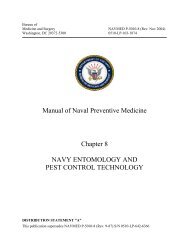3440.10 with Changes - Navy Medicine - U.S. Navy
3440.10 with Changes - Navy Medicine - U.S. Navy
3440.10 with Changes - Navy Medicine - U.S. Navy
You also want an ePaper? Increase the reach of your titles
YUMPU automatically turns print PDFs into web optimized ePapers that Google loves.
BUMEDINST <strong>3440.10</strong><br />
20 Nov 2008<br />
should also include MTF EM coordination <strong>with</strong> nearby military installations of other Services<br />
including the U.S. Coast Guard, and local medical community organizational planning such as<br />
through local emergency planning committees.<br />
i. Joint Information Center (JIC). MTF commanders shall coordinate <strong>with</strong> region and<br />
installation EM staffs to identify and update points of contact for public affairs, risk communication,<br />
emergency protocols, and media expectations.<br />
FHP EMP Standard 7: Planning<br />
1. The <strong>Navy</strong> <strong>Medicine</strong> FHP EMP establishes minimum planning standards as required by<br />
reference (a) of this section. Planning is critical to preparedness, prevention, mitigation,<br />
response, and recovery from an emergency. The MTF EM Plan must be coordinated <strong>with</strong> the<br />
installation plan, if the MTF is a tenant command, or <strong>with</strong> the regional plan, if the MTF is a<br />
stand-alone installation.<br />
2. All <strong>Navy</strong> <strong>Medicine</strong> MTF EM Plans shall be reviewed at least annually and provided to the<br />
immediate superior in command (ISIC). Elements of the MTF EM Plan must be coordinated<br />
<strong>with</strong> the applicable <strong>Navy</strong> and USMC region, and installation-specific EM Plans and exercises.<br />
The MTF EM Plan should also be coordinated <strong>with</strong> Federal, State, tribal, local, other-Service, or<br />
HN, and/or private response and/or recovery partners.<br />
3. Evacuation planning, shelter-in-place planning, and shelter development procedures should<br />
be based upon applicable DoD, Department of Homeland Security (DHS), and American Red<br />
Cross (ARC) guidelines. Evacuation, rather than procurement and employment of protective<br />
equipment, is the primary means of addressing hazards faced by Category 2 personnel. In<br />
overseas locations, evacuations will follow established U.S. DoS evacuation procedures.<br />
4. Per reference (b) of this section, <strong>Navy</strong> region and installation commanders shall develop<br />
plans and procedures to direct Category 2 through 4 personnel to safe locations, shelters, or to a<br />
shelter-in-place should evacuation not be an option. When shelter-in-place is utilized, the goal<br />
will be to protect at least 90 percent of personnel <strong>with</strong>in 15 minutes. MTF commanders and<br />
EMOs shall communicate regularly and coordinate closely <strong>with</strong> region or installation EM<br />
planning processes.<br />
5. Additional aspects of planning that must be incorporated are:<br />
a. Assistance to requesting commanders in identifying a PHEO per reference (n) of this<br />
section.<br />
b. Participation in the MBAC per reference (c) of this section.<br />
c. Liaison <strong>with</strong> the installation EOC and ROC.<br />
15 Enclosure (1)
















